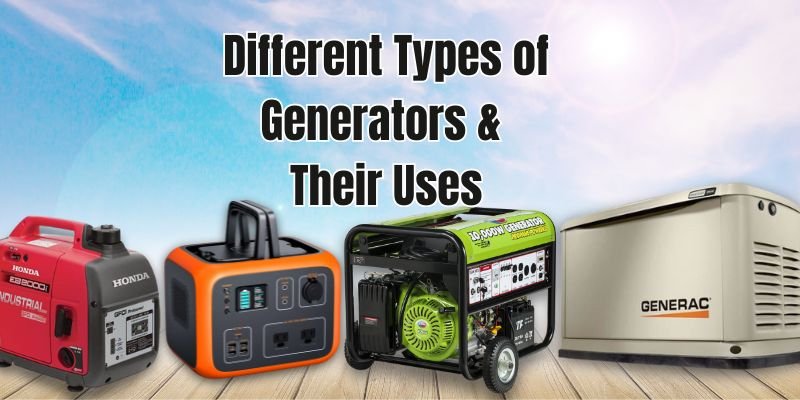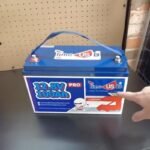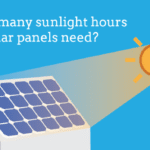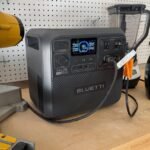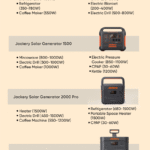Disclosure: This post contains affiliate links and I will be compensated if you make a purchase after clicking through my links. Learn More
To run an extension cord from a generator into a house, first ensure that the generator has the required power capacity and is located outdoors in a well-ventilated area. Then, use a heavy-duty, outdoor-rated extension cord with the appropriate wattage rating to connect the generator to a transfer switch or a manual interlock device installed near the main electrical panel in the house.
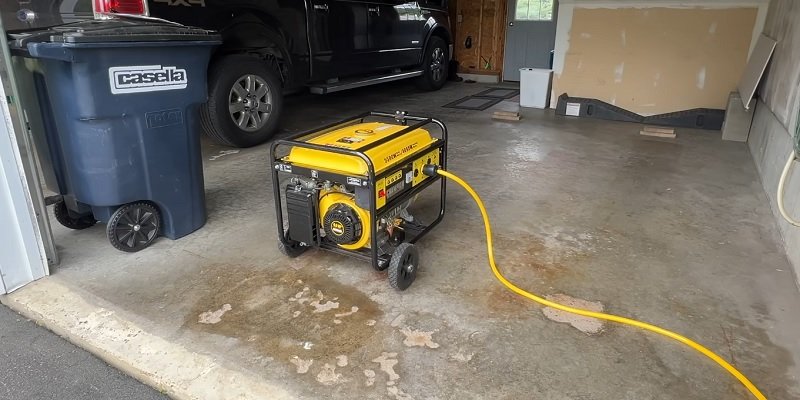
This allows selected circuits to be powered by the generator while disconnecting them from the main power grid. It is important to follow all safety guidelines and ensure that the generator and extension cord are properly grounded to prevent any electrical hazards.
Choosing The Right Extension Cord
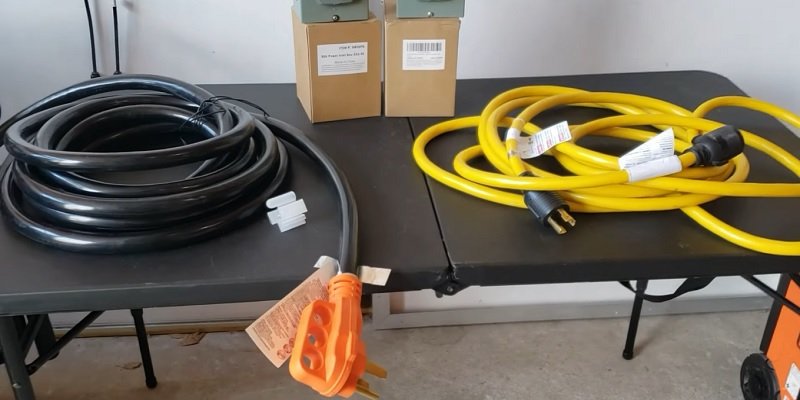
Factors To Consider When Selecting An Extension Cord For Your Generator
When it comes to running an extension cord from your generator into your house, choosing the right one is crucial. A well-suited extension cord ensures a safe and reliable connection between your generator and appliances. Here, we will discuss the key factors you should consider when selecting an extension cord for your generator:
Gauge And Length Specifications To Match Your Power Needs
One of the most important factors to consider is the gauge and length specifications of the extension cord. The gauge indicates the thickness of the wire inside the cord, and a lower gauge number means a thicker wire and higher capacity for carrying electrical current. Additionally, the length of the cord impacts its overall capacity to deliver power without voltage drop.
For generators, the recommended gauge and length specifications are as follows:
| Generator Capacity | Recommended Gauge (AWG) | Maximum Cord Length |
|---|---|---|
| Up to 1,200 watts | 16 | 25 feet |
| Up to 1,800 watts | 14 | 50 feet |
| Up to 2,500 watts | 12 | 100 feet |
| Above 2,500 watts | 10 | Up to 200 feet |
Understanding The Difference Between Indoor And Outdoor Extension Cords
Another important consideration is differentiating between indoor and outdoor extension cords. Indoor extension cords are designed for use in dry locations, while outdoor extension cords are built to withstand various weather conditions and are waterproof. It is essential to choose the appropriate type based on where you plan to use the cord.
Outdoor extension cords have additional layers of insulation and are typically labeled as such. They provide better protection against moisture, sunlight, and other outdoor elements. Using an indoor extension cord outdoors can lead to safety hazards and potentially damage the cord.
By carefully considering factors like gauge and length specifications and differentiating between indoor and outdoor extension cords, you can select the right extension cord that suits your power needs and ensures a safe and efficient connection between your generator and house.
Ensuring Safety And Proper Usage
Running an extension cord from your generator into your house can be a convenient alternative when the power goes out. However, it is crucial to prioritize safety and proper usage to avoid any electrical hazards or damage. In this section, we will discuss the precautions you should take when running an extension cord from your generator, the benefits of using a transfer switch for seamless power transfer, and the importance of grounding both the generator and the extension cord for electrical safety.
Precautions To Take When Running An Extension Cord From Your Generator
Before connecting your generator to your house using an extension cord, it is essential to follow a set of precautions to ensure safety and prevent any potential hazards:
Use a heavy-duty extension cord: When selecting an extension cord for this purpose, make sure it is rated for outdoor use and capable of handling the power output of your generator. Opt for a cord with a higher amp rating than the generator’s output to avoid overloading.
Inspect the extension cord: Before each use, carefully examine the cord for any damage, such as frayed wires or broken insulation. If you notice any signs of wear and tear, it is crucial to replace the cord immediately to prevent electrical shocks or fire hazards.
Keep the extension cord dry: Water and electricity are a dangerous combination. Ensure that the extension cord remains dry throughout its usage. Keep it away from wet surfaces, puddles, or other sources of moisture to avoid electrical accidents.
Avoid overloading the extension cord: Do not plug multiple high-power appliances into a single extension cord. Overloading the cord can lead to overheating and potentially cause a fire. Instead, distribute the load by using multiple cords and power strips.
Do not run the extension cord through doorways or windows: To prevent wear and tear or accidental damage to the cord, avoid routing it through doorways, windows, or any other tight spaces where the cord may get pinched or crushed. Use alternative methods, such as drilling holes or using specialized cable ports, to create safe pathways.
Using A Transfer Switch For Seamless Power Transfer
In situations where you frequently rely on a generator for backup power, investing in a transfer switch is highly recommended. A transfer switch enables smooth and safe power transfer from the generator to your house’s electrical system. Here are a few benefits of using a transfer switch:
Safety: A transfer switch isolates your house’s electrical system from the main power grid, preventing backfeeding and protecting utility workers. It ensures that only one power source is active at a time, avoiding potential electrical accidents.
Convenience: With a transfer switch, you can easily switch between utility power and generator power without the need for manual unplugging and plugging of the extension cord. It provides a reliable and automatic solution, saving you time and effort during power outages.
Power management: Some transfer switches come with additional features like load shedding, which enables you to prioritize power distribution to essential appliances during times of limited generator capacity.
Grounding The Generator And Extension Cord For Electrical Safety
Proper grounding is essential to maintain electrical safety when running an extension cord from your generator into your house. Grounding helps to prevent electrical shock and minimizes the risk of fire. Here’s why grounding is crucial:
Electrical stability: Grounding the generator creates a path for electrical faults to safely dissipate, protecting the generator and your electrical system from damage.
Reduced risk of electric shock: Proper grounding channels any stray electrical current to the ground, preventing it from flowing through you or your appliances.
Compliance with electrical codes: In many areas, grounding the generator is required by electrical codes to ensure the safety of both the user and the utility workers.
Ensure that both your generator and the extension cord are properly grounded according to the manufacturer’s instructions and local electrical codes. Consult a qualified electrician for assistance if needed to guarantee the correct installation and grounding procedures.
Routing The Extension Cord
When it comes to powering your house during a power outage or running electrical appliances in your backyard, using a generator is a reliable solution. However, once you have your generator set up outside, you need to find a way to connect it to your house to ensure a safe and efficient power supply. This is where routing the extension cord becomes crucial.
Locating A Suitable Entry Point For The Extension Cord Into Your House
Before you start routing the extension cord, you need to locate a suitable entry point into your house. This will ensure a seamless connection without compromising insulation or security. Here are a few steps to help you find the perfect spot:
Identify an exterior wall close to the generator: Look for a convenient wall near the generator where you can run the cord from the outside to the inside.
Choose a location near an electrical outlet: Select a spot that is near an existing electrical outlet inside your house. This will make it easier to connect the extension cord to power your appliances.
Consider accessibility and safety: Ensure the entry point is easily accessible and safe to navigate for anyone needing to connect or disconnect the extension cord.
Protecting The Cord From Damage And Weather Elements
Once you’ve determined the entry point for your extension cord, it’s crucial to protect it from any potential damage or exposure to adverse weather conditions. Here are some effective ways to keep your cord safe:
Use a conduit or raceway: Installing a conduit or raceway can provide excellent protection for the extension cord, shielding it from accidental damage and weather-related wear and tear.
Secure the cord with cable clips or hooks: Using cable clips or hooks, affix the extension cord along the wall or the baseboard to keep it firmly in place and prevent tripping hazards.
Elevate the cord: If the entry point is at ground level, consider elevating the cord using hooks or clips. This will prevent it from getting caught on debris or being damaged by foot traffic.
Use weatherproof covers: In situations where the extension cord is exposed to the elements, invest in weatherproof covers to shield it from rain, snow, and UV rays.
Navigating Through Doors And Windows Without Compromising Insulation Or Security
When routing the extension cord through doors and windows, it’s essential to maintain proper insulation and security. Here’s how to do it:
Utilize weatherstripping and door sweeps: To seal any gaps created by the extension cord when passing it through doors and windows, use weatherstripping and door sweeps. This will help maintain insulation and keep drafts out.
Avoid fully closing doors and windows: Instead of closing doors or windows all the way, leave a small gap to feed the extension cord through. This ensures that the cord is protected while maintaining the overall security of your home.
Consider removable window seals: If you frequently need to run the extension cord through a specific window, investing in removable window seals or panels can provide a convenient and secure entry point while preserving insulation.
By following these steps and taking necessary precautions, you can successfully route your extension cord from the generator into your house, ensuring a reliable power supply without compromising the safety and integrity of your home.
Managing Power In Your Home
When it comes to running an extension cord from a generator into your house, managing power is of utmost importance. Without proper management, you risk overloading your electrical system and damaging appliances and devices. In this article, we will explore some key strategies for effectively distributing power, utilizing power strips or surge protectors, and monitoring power load to avoid overload scenarios.
Distributing Power To Essential Appliances And Devices
When connecting your generator to your house, it is crucial to prioritize the distribution of power to essential appliances and devices. By doing so, you can continue to power the most critical components of your home, such as refrigerators, heating systems, or medical equipment in case of an emergency. Consider creating a prioritized list of the appliances and devices that you absolutely need to keep running during a power outage.
Next, determine the wattage requirements for each of these essential items by referring to their user manuals or conducting a quick online search. This information will help you choose the appropriate extension cord and ensure that it can handle the power demands of your appliances and devices.
Remember, it’s important to choose a high-quality extension cord that is specifically designed for outdoor use and capable of handling heavy loads. Look for cords with a sufficient gauge to minimize voltage drop and maximize efficiency.
Utilizing Power Strips Or Surge Protectors For Multiple Connections
If you have multiple appliances or devices that need to be powered, a power strip or surge protector can come in handy. These devices allow you to connect multiple devices to a single power source, reducing the number of extension cords needed and simplifying the setup.
When selecting a power strip or surge protector, opt for models with built-in safety features such as overload protection and surge suppression. These features safeguard your appliances and devices from power surges, spikes, and electrical hazards, providing you with peace of mind.
Remember, it’s essential not to overload a power strip or surge protector. Always check the amp rating of the device and ensure that the combined wattage of your connected appliances and devices does not exceed that rating. Overloading can lead to overheating and pose a fire risk.
Monitoring Power Load And Avoiding Overload Scenarios
Monitoring your power load is critical to avoid overloading your generator or home electrical system. Exceeding the power limit can cause the circuit breaker to trip or damage the generator, leaving you without power.
One way to monitor power load is by using a portable wattage meter or power usage monitor. These devices provide real-time insight into how much power your appliances and devices are consuming, allowing you to make informed decisions about which items can stay connected and which ones need to be disconnected to prevent overload.
Additionally, familiarize yourself with the wattage capacity of your generator or the circuit breaker that supplies power to your house. This will help you determine the maximum load your system can handle and avoid pushing it beyond its limits.
As an extra precaution, it’s always a good idea to periodically check the temperature of your extension cords, power strips, or surge protectors. If any of these components feel hot to the touch, it may indicate an excessive load, and adjustments should be made accordingly.
By following these guidelines for managing power in your home, you can ensure a safe and efficient setup when running an extension cord from a generator into your house. Proper distribution of power, the use of power strips or surge protectors, and vigilant monitoring of power load will help you avoid overload scenarios and maintain a reliable power supply during emergencies or planned outages.
Frequently Asked Questions Of How To Run Extension Cord From Generator Into House?
How To Hook Up A Generator To Your House When The Power Goes Out?
To hook up a generator to your house when the power goes out, follow these steps:
- 1. Purchase a transfer switch and a generator.
- 2. Install the transfer switch near your electrical panel.
- 3. Connect the generator to the transfer switch using a power cord.
- 4. Start the generator and switch on the transfer switch.
- 5. Enjoy power to your house during an outage.
How Do I Hook Up A Generator To My House Without A Transfer Switch?
To connect a generator to your house without a transfer switch, you’ll need to use a heavy-duty power cord to plug the generator directly into a compatible outlet in your home. Make sure to follow safety precautions and consult a professional if you’re unsure.
Can A Portable Generator Be Hard Wired To The House?
Yes, a portable generator can be hard wired to a house. This allows for a more convenient and reliable source of backup power during outages. However, professional installation is necessary to ensure safety and compliance with electrical codes.
How Many Extension Cords Can You Run Off A Generator?
You can safely run multiple extension cords off a generator, but the exact number depends on the wattage capacity of the generator and the power requirements of the devices you’re connecting. It’s important to calculate the total wattage and ensure it doesn’t exceed the generator’s capacity to avoid overloading.
Final Thoughts
To summarize, running an extension cord from a generator into your house can provide you with a practical solution during power outages or when you need additional power sources. By following the necessary safety precautions and using the right equipment, you can ensure a seamless and efficient connection.
Remember to consider the load capacity of your generator, use heavy-duty extension cords, and always prioritize safety. With these essential steps in mind, you can confidently and safely power your house using an extension cord from your generator.

